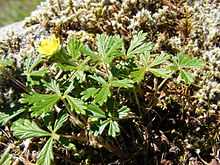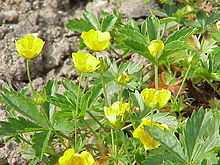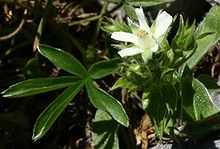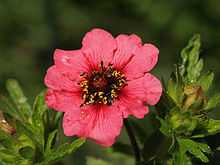Potentilla
| Potentilla | |
|---|---|
 | |
| Potentilla arenaria | |
| Scientific classification | |
| Kingdom: | Plantae |
| (unranked): | Angiosperms |
| (unranked): | Eudicots |
| (unranked): | Rosids |
| Order: | Rosales |
| Family: | Rosaceae |
| Subfamily: | Rosoideae |
| Genus: | Potentilla L. |
| Species | |
|
About 300-500, see text and Species of Potentilla | |
| Synonyms | |
|
Duchesnea | |
Potentilla /ˌpoʊtənˈtɪlə/[1] is a genus containing over 300[2] species of annual, biennial and perennial herbaceous flowering plants in the rose family, Rosaceae. They are usually called cinquefoils in English. Potentilla are generally holarctic in distribution, though some may even be found in montane biomes of the New Guinea Highlands. Several other "cinquefoils" formerly included here are now separated in distinct genera.
Some species are called tormentils, though this is often used specifically for common tormentil (P. erecta). Others are referred to as "barren strawberries", which may also refer to P. sterilis in particular, or to the closely related but not congeneric Waldsteinia fragarioides.
Nomenclature
"Cinquefoil" in the Middle English Dictionary is described as "Pentafilon – from Greek Pentaphyllon – influenced by foil, a leaf. The European cinquefoil (Potentilla reptans), often used medicinally."[3] The word is derived from Old French cinc, Middle English cink and ultimately Latin quinque – all meaning "five" –, and feuille and foil/foille which mean "leaf". Formerly this term referred to five-leaved plants in general. In medieval times, the word "cinquefoil" was used almost exclusively in England. In France, the genus was called quintefeuille, first attested in Normandy and Brittany in the 11th century.
The scientific name seems to have been influenced by a fusion of ancient names for these plants. Common tormentil, P. erecta, was known as tormentilla in medieval Latin, derived from early Spanish – literally "a little torment", meaning pain that, while not debilitating, is unpleasant and persistent (such as a stomach ache, against which P. erecta was used). The change from initial "t" to "p" seems to have been influenced by terms such as poterium – Latin for the related burnets (genus Sanguisorba) – or propedila and similar words used for the European cinquefoil (P. reptans) in the now-extinct Dacian language, as attested in Latin herbals.[citation needed]
In another medieval dictionary the French word potentille is defined as a "wild Tansie, a silver weed",[4] a reference to the tansy (Tanacetum vulgare) and similar taxa of the genus Tanacetum. The related adjective potentiel/potentiells means "strong", "forcible", or "powerful in operation". Its origin is the French potence ("strong", "powerful", "mighty", or "potent"). The origin of these words is the Latin potens, with the same meaning.
Description and ecology

Typical cinquefoils look most similar to strawberries, but differ in usually having dry, inedible fruit (hence the name "barren strawberry" for some species). Many cinquefoil species have palmate leaves. Some species have just three leaflets, while others have 15 or more leaflets arranged pinnately. The flowers are usually yellow, but may be white, pinkish or red. The accessory fruits are usually dry but may be fleshy and strawberry-like, while the actual seeds – each one technically a single fruit – are tiny nuts. Cinquefoils grow wild in most cool and cold regions of the world. Most species are herbaceous perennials but a few are erect or creeping shrubs. Some are troublesome weeds. Other types are grown in gardens.
Cinquefoils are a prominent part of many ecosystems. In the United Kingdom alone, common tormentil (P. erecta) together with purple moor grass (Molinia caerulea) defines many grassy mires, and grows abundantly in the typical deciduous forest with downy birch (Betula pubescens), common wood sorrel (Oxalis acetosella), and sessile oak (Quercus petraea). In upland pastures on calcareous soil it typically accompanies common bent (Agrostis capillaris), sheep's fescue (Festuca ovina), and wild thyme (Thymus praecox). It is most commonly seen in regions dominated by common heather (Calluna vulgaris), including common lowland heaths with bell heather (Erica cinerea), maritime heaths with spring squill (Scilla verna), submontane heaths dominated by red peat moss (Sphagnum capillifolium) and common bilberry (Vaccinium myrtillus), and the mountain heathlands of Scotland with alpine juniper (Juniperus communis ssp. alpina).
The leaves of cinquefoils are eaten by the caterpillars of many Lepidoptera, notably the grizzled skippers (genus Pyrgus), butterflies of the skipper family. Adult butterflies and moths visit cinquefoil flowers; for example, the endangered Karner blue butterfly (Lycaeides melissa samuelis) takes nectar from common cinquefoil (P. simplex). The Polish cochineal (Porphyrophora polonica), a scale insect once used to produce red dye, lives on cinquefoils and other plants in Eurasia. Some, but not all, cinquefoils are insect-pollinated, producing nectar that lures bees, hoverflies, muscid flies, butterflies, true bugs, and ants.[2]
Uses
Horticulture

Some cinquefoils are grown as ornamental plants. These are generally high species with bright, showy flowers, such as ruby cinquefoil (P. atrosanguinea), Nepal cinquefoil (P. nepalensis), and sulphur cinquefoil (P. recta). Horticultural hybrids such as Hopwood's cinquefoil (Potentilla × hopwoodiana) and tongue cinquefoil (Potentilla × tonguei) have been bred, and there exists a range of cultivars. Some double-flowered cinquefoils have been bred, starting with Victor Lemoine's 'Gloire de Nancy' in 1854. Other taxa and varieties are useful for more specialized gardening purposes, such as rock gardens or swamps. Among the former is the hardy spring cinquefoil (P. neumanniana), the floral emblem of Cromartyshire.
Health
Some species are used in herbalism. Common tormentil (P. erecta), for example, has been used as an herbal remedy for inflammation and gastrointestinal disorders.[5] Research continues to determine its safety and usefulness as an alternative medicine for such disorders as ulcerative colitis.[6] Potentilla discolor[7] and P. multifida[8] are Chinese medicinal herbs used to treat diabetes.
Art
In heraldry, the cinquefoil emblem or potentilla signified strength, power, honor, and loyalty. Depiction of the five-petaled flower appears as early as 1033, in the architecture of the church built in the village of Reulle-Vergy in Burgundy, France, two years before the reign of William the Conqueror. The cinquefoil emblem was used generously in the architecture of numerous churches built in Normandy and Brittany through the 15th century.
From the 11th to 14th century, the word potence, related to potentilla, was used mainly in a military context and to describe the condition of the soul. During the time of William the Conqueror, the potentilla was used as an emblem on the coat of arms of Bardolph of Bretagne, who in 1066 was the master of the William's military engineer corps.
Systematics and taxonomy
.jpg)
Analysis of internal transcribed spacer DNA sequence data has yielded valuable information on cinquefoil relationships, supporting previous hypotheses about their relationships, but also resulting in a number of changes to the circumscription of Potentilla.[9]
Among the Rosaceae, the typical cinquefoils are close relatives of such plants as the avens (genus Geum) and the roses (genus Rosa), and even closer relatives of the agrimonies (Agrimonia). Yet more closely related to Potentilla are the lady's mantles (Alchemilla) and the strawberries (Fragaria). Genus Dryas is not as closely related as long believed.
The genera Horkelia (horkelias) and Ivesia (mousetails) are sometimes included in Potentilla today. The mock-strawberries of Duchesnea have been included. Conversely, the shrubby plants previously included in this genus are well distinct and now separated in the genus Dasiphora, while some distinctive and apparently protocarnivorous[10] herbaceous cinquefoils are placed in Drymocallis. The marsh cinquefoil is now in the genus Comarum, and the three-toothed cinquefoil makes up the monotypic genus Sibbaldiopsis. As already proposed by John Hill in the 18th century, the silverweeds of genus Argentina may be distinct, but as the immediate sister genus of Potentilla, its boundary is still unclear.
Estimates of the number of valid species in this large genus depend on the circumscription used, and they recently vary from "over 300"[2] to 400[11] to 500[12][13][14] to "several hundred".[15]
Selected species




|
|
| Wikimedia Commons has media related to Potentilla. |
Formerly included here
References
- ↑ Sunset Western Garden Book. 1995. 606–07.
- ↑ 2.0 2.1 2.2 Guillén, A., et al. (2005). Reproductive biology of the Iberian species of Potentilla L. (Rosaceae). Anales del Jardín Botánico de Madrid 1(62) 9-21.
- ↑ Kuhn, S. H. Middle English Dictionary.
- ↑ Cotgrave, R. (1611). A Dictionarie of the French and English Tongues.
- ↑ Shushunov, S., et al. (2009). Determination of acute toxicity of the aqueous extract of Potentilla erecta (tormentil) rhizomes in rats and mice. Journal of Medicinal Food 12(5), 1173-76.
- ↑ Huber, R., et al. (2007). Tormentil for active ulcerative colitis: an open-label, dose-escalating study. Journal of Clinical Gastroenterology 41(9), 834-38.
- ↑ Yang, J., et al. (2010). Anti-diabetic effect of standardized extract of Potentilla discolor Bunge and identification of its active components. Drug Development Research 71(2), 127-32.
- ↑ Xue, P., et al. (2007). Simultaneous determination of seven flavonoids in Potentilla multifida by HPLC. Journal of Chromatographic Science 45(4), 216-19.
- ↑ Eriksson, T., et al. (2003). The phylogeny of Rosoideae (Rosaceae) based on sequences of the internal transcribed spacers (ITS) of nuclear ribosomal DNA and the TRNL/F region of chloroplast DNA. International Journal of Plant Sciences 164(2) 197–211. doi:10.1086/346163
- ↑ Spoomer, G. G. (1999). Evidence of protocarnivorous capabilities in Geranium viscosissimum and Potentilla arguta and other sticky plants. International Journal of Plant Sciences 160(1) 98-101. doi:10.1086/314109
- ↑ Potentilla. The Jepson eFlora 2013.
- ↑ Potentilla. Flora of China.
- ↑ Eriksen, B. and M. H. Töpel. (2006). Molecular phylogeography and hybridization in members of the circumpolar Potentilla sect. Niveae (Rosaceae). American Journal of Botany 93(3), 460-69.
- ↑ Castagnaro, A., et al. (1998). A new southern hemisphere species of Potentilla (Rosaceae). Novon 8(4), 333-36.
- ↑ Faghir, M. B., et al. (2010). Leaf indumentum types in Potentilla [Rosaceae] and related genera in Iran. Acta Societatis Botanicorum Poloniae 79(2), 139-45.
- ↑ Micevski, K. (1998). Flora in the Republic of Macedonia. MANU, 1.
- ↑ "CWRIS PGR Forum Crop Wild Relative Information System". CWRIS. Retrieved 2010-08-26.
External links
- Species of Potentilla. The Plant List. Retrieved 2013-05-28.

